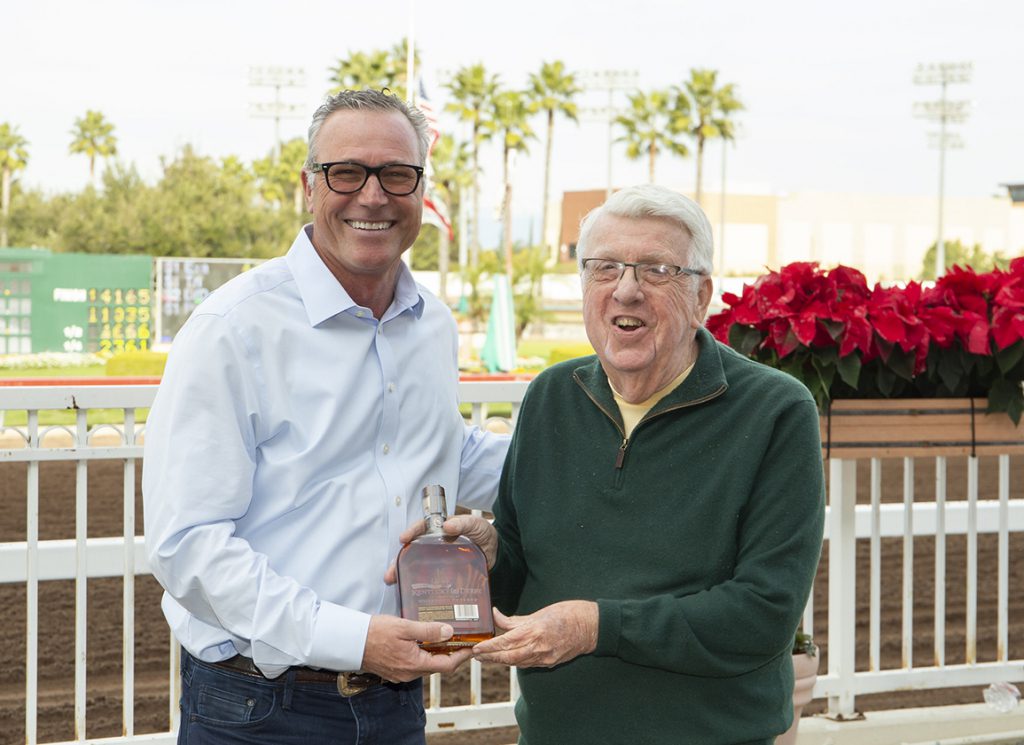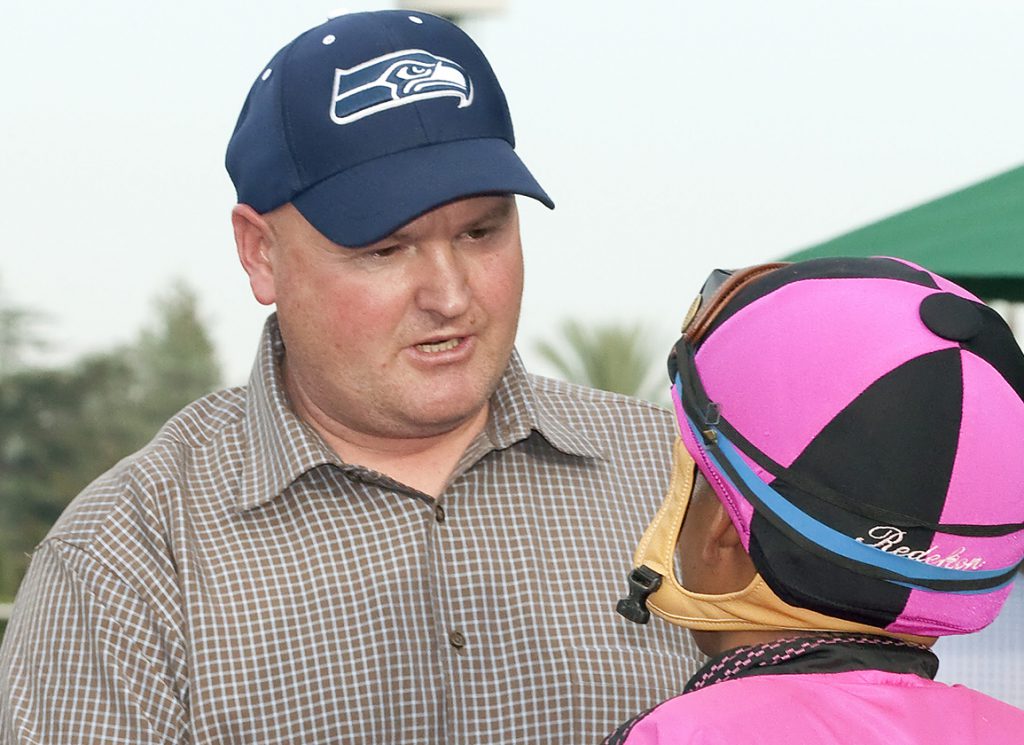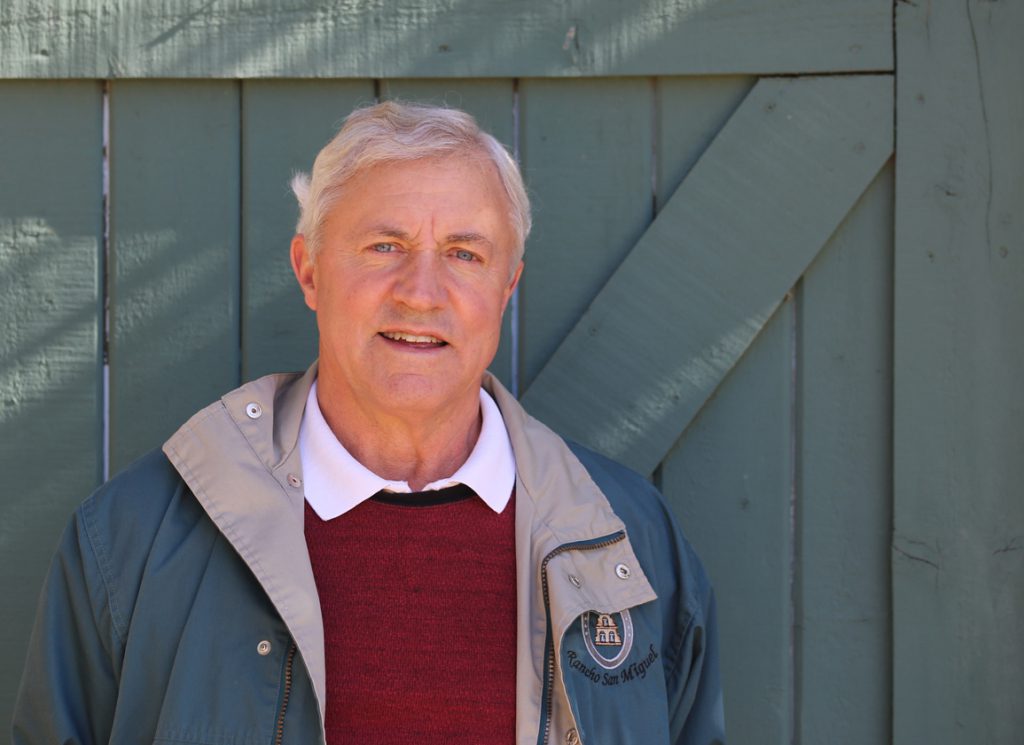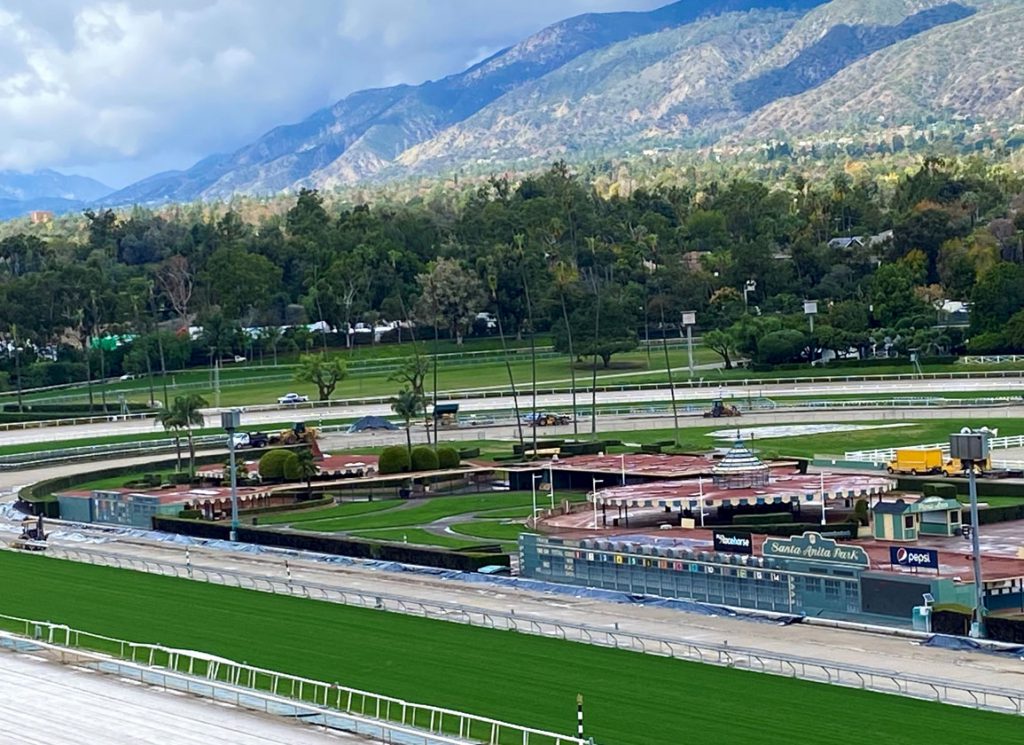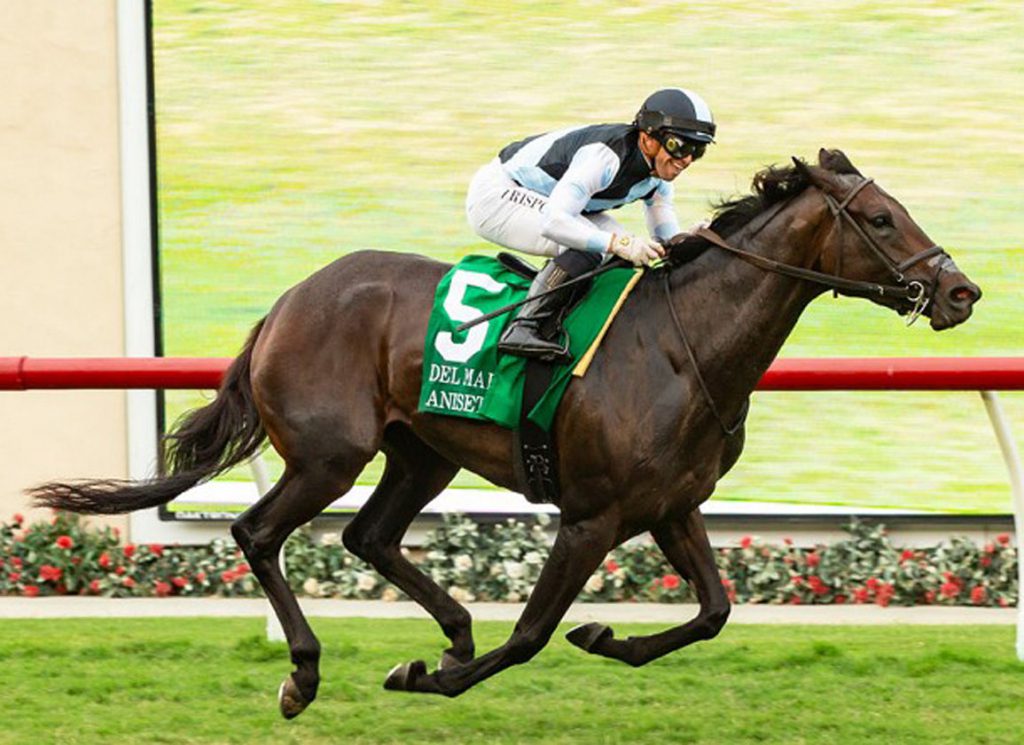Nearly seventy years ago, Sports Illustrated turf writer, Jim Murray, penned a love-letter to Santa Anita, and its opening day sonata of sun and sport unmatched by any East Coast oval stunned into icy retreat by the “fierce howlings of blue northers spun across finish lines.”
Santa Anita, Murray wrote, was an “extravagance of beauty.” It was also a well-oiled money-spinner. Huge purses lured the best horses to Los Angeles, and the best horses lured the biggest crowds, their pockets brimming with the spoils of a post-war industrial boom transforming this callow cow-town into a maven of modernity.
“One day (Handicap Day in 1947), so many people showed up (85,500) that a crisis was created (the plumbing caved in under the strain) and the card almost had to be canceled,” Murray wrote.
This year's opening day at Santa Anita tells a different tale. A crowd of over 37,000 contributed to the “best handle ever among a total of 17 opening dates conducted on a Tuesday,” as the track's publicity department put it.
Putting inflation adjustments aside for the moment, that still constitutes a 30% drop from last year's total–the sort of back-foot number stakeholders desperately wanted to avoid as the track embarks upon another grueling six-month marathon into one of the most consequential years yet for the state's racing industry.
Amid an economic landscape of consolidation and contraction–which gives the distinct impression of a giant puzzle set where the pieces don't quite fit together–decisions will be made that will set this ship's course for the foreseeable future. Icebergs abound.
The compass guiding many of these decisions is this spinning dial: Can a sustainable long-term racing circuit in Northern California be pieced together in the void left by Golden Gate Fields?
TDN tried unsuccessfully in recent weeks to reach California Association of Racing Fairs (CARF) executive director, Larry Swartzlander. The LA Times, however, this week quoted Swartzlander as saying that he was “60%” certain a deal could be reached whereby the fair circuit would take over Golden Gate's dates, though would likely reduce them from 132 days a year to 103.
Tom “Bomber” Doutrich, CARF racing secretary, told the TDN he's “hopeful” an announcement about any such plan will arrive early in 2024. “There are two things you can say about CARF,” he added. “We need to get the purses right. And we've got to get a facility that we can turn into a top-class facility. We're working on that right now.”
NORCAL
To say that time is of the essence when it comes to these negotiations does a gross disservice to ticking clocks everywhere, as well as to the heads of racing operations juggling families, employees and their own tentative futures.
Golden Gate Fields is scheduled to race through June 9, 2024, after which the facility is set to close permanently. Next year's fair schedule is currently set to close out with a fall fair meet at Fresno from Oct. 2 through the 13th.
In the aftermath of the announced closure of Golden Gate, Swartzlander made several proposals for a restructured Northern California circuit, including a permanent base split between Santa Rosa and Cal Expo, or only at the latter track.
But such plans would require reaching an agreement with California's harness racing industry, which only last year extended its lease of operations of the Cal Expo Harness racetrack until May 2030.
In the event no concrete proposal for Northern California materializes, a legislative fix may be sought to expand the menu of Thoroughbred races offered at Los Alamitos, said Bill Nader, president of the Thoroughbred Owners of California (TOC).
“We're on the clock and we're moving into 2024, so we have come up with alignment between the three tracks in the south for horses in the north to have suitable opportunities to compete in the south at Los Alamitos, Del Mar or Santa Anita,” said Nader.
This “alignment,” explained Nader, would include a statutory change to permit Los Alamitos–outside of their scheduled Thoroughbred meets–to stage Thoroughbred races beyond the current limit: 4 1/2 furlong races capped at a $5,000 claiming price.
“Provided there's no operator or plan that comes forth in the north, it would allow for those horses to remain in California and have a suitable opportunity to compete within their own state seamlessly. At least we have that,” said Nader, about such a proposal.
According to Jack Liebau, vice president of Los Alamitos, a legislative fix to go into immediate effect–as opposed to the start of January 2025, like most bills passed next year–needs an “urgency clause” requiring a two-thirds vote by the legislature.
“I think we can get the legislative change if it's fully supported by the industry as a whole. I don't know why anybody would oppose that,” said Liebau. “The devil, of course, will be in the details.”
According to Liebau, Los Alamitos can accommodate around 300 additional horses. In Golden Gate right now, there are around 1,150 horses.
But how motivated are trainers currently stabled at Golden Gate to funnel their horses south, in the event plans to furnish an alternative Northern calendar fall apart?
Answers are buffeted by other gusty headwinds. Purses at Golden Gate's final meet have been slashed by 25%, a result of the purse account being overdrawn by $3.1 million. (Nader told the TDN that Santa Anita's purse account is also in the red to the tune of $3.7 million)
In January, Berkeley City Council might vote on an ordinance that could essentially close Golden Gate before its anticipated June curtain call.
Ed Moger, a leading trainer at Golden Gate, recently said that while a 25% purse cut would likely spur some barns to cross state lines and relocate to Turf Paradise, he might shift a significant portion of his horses to Santa Anita instead.
“It's tougher to win a race at Santa Anita,” said Moger, at the time. “I'll have to play it by ear.”
But not everyone appears as ready to pack up box and truck for a trip south–not trainer Tim McCanna, who said that such a wholesale move would come only after every other alternative had been exhausted.
“Seventy-five percent of the horses in the north won't fit the south,” McCanna explained, estimating that about 15 of his 40-horse Golden Gate string might suit the Southern circuit. “Most of the trainers can't go there either,” he added, alluding to the increased costs of Southern California living.
McCanna said he's “quite hopeful” an alternative Northern California circuit can be pieced together. But he also feels as though the Northern California trainer colony has been largely ignored by industry leadership during the travails of the past year.
“We were ambushed by this,” said McCanna, adding that an ownership group had recently moved five of his horses to Turfway Park, because of the purse cuts.
“The mood around the track is that it feels like we've been shot in the back,” said trainer Blaine Wright, who currently has around 50 horses at Golden Gate. “My clientele is not very happy with this purse reduction.”
Like McCanna, Wright is playing it by ear, hoping that in the New Year, news of a new viable Northern California circuit will trickle through.
If it doesn't, Wright said that he's already warned two of his staunchest patrons that the tough economics of maintaining a SoCal barn might behoove them to shut up shop.
“I said to them, 'if you don't want to race on the West Coast and you'd like to go to the Midwest or East where things are happening good, that would be fine,'” said Wright. “But I warned them, 'if you want to stay on the West Coast, my advice would be to get out of the business because the horses we have aren't going to do at Santa Anita.'”
Wright added: “How do you tell the people who have basically made your living for 16 years to get out of the business? I'm just trying to be truthful when I'm telling them I think the writing's on the wall here and the end's coming soon.”
BREEDERS
Back in August, long-time owner and breeder, Nick Alexander, warned the consolidation of racing in the south would be a body blow for the state's breeding industry. Has his thinking evolved since?
“No, is the short answer,” said Alexander, who added that he still expects to maintain his 35-strong broodmare band through next year.
From a squad of five racehorses previously at Golden Gate, Alexander has shifted three south, and plans to do the same with one of the other two horses remaining. More broadly, he said he's “not optimistic” an alternative Northern racing circuit can be formed.
“It's a damn shame for the breeders up there,” said Alexander. “I'm 81 years old. If I was fifty and had kids in college and was trying to be a trainer in Northern California, what the hell would I do?”
Adrian Gonzalez of Checkmate Farm-a 66-acre ranch in Parkfield, California-is one of those trying to build a business for his young family.
Of Gonzalez's 30-strong broodmare band, about half are headed to Kentucky stallions, he said, and he's in two minds whether to bring them back to California to foal.
“If there's no commercial market left in California, we need to make sure our stock is something that can be sought after in other markets,” Gonzalez said. “Most of our clients are doing something similar,” he added.
Given this trend, Gonzalez said he's concerned about a sharp dip in Cal-breds in three years–what would be especially troubling if the state racing industry can be fortified against further erosion in the meantime, he added.
“The long-term impacts are definitely something we need to be focused on,” said California Thoroughbred Breeding Association (CTBA) president, Doug Burge.
As positives, Burge singled out how active California buyers were at Keeneland's November breeding stock sale. While Golden Gate's purses have been cut, he added, lucrative Cal-bred bonuses remain in place.
“I think in the future we'll see a major focus on quality,” Burge said, pointing to the recent run high-profile successes for horses bred in the state, including a 1-2 finish in the recent G1 La Brea S. for Cal-breds. “But we obviously need the numbers as well.”
Indeed, while California's foal crop has steadily declined–by nearly 25% between 2012 and 2021–Cal-breds have been playing an ever more important role in propping up the California racing calendar.
During Santa Anita's 2022-2023 six-month meet, Cal-breds made up about 37% of all individual starts, and Cal-bred races constituted more than 20% of the overall races carded.
Is there a number of foals bred annually below which the state's breeding industry becomes an unsustainable model?
“That depends on how much racing we'll have here in the next few years,” Burge said. “When you announce the closure of a major racetrack, it's obviously going to have a major impact.”
Tom Clark, the owner and manager of Rancho San Miguel–a mainstay of the state's breeding industry–estimates double digit declines in the number of mares bred in the state next year. Last year, 1,874 mares were bred to California stallions. Twenty years prior, the number was about three-times that.
“The response so far from clients generally has been to cut back or exit the breeding industry in the state,” said Clark. “The only exceptions are some of the larger farms–Barton [Thoroughbreds] and John Harris and Loveacres [Ranch]–who have continued to invest in broodmares for their own account.”
While the popularity of Clark's stallions means Rancho San Miguel has so far been fairly insulated from the worst of the declines, he said, unintended consequences are percolating through.
“I've got about 20 mares people want me to find homes for,” said Clark. “I just gave three away to new homes as of this morning. It's happening.”
Which begs the question: How will recent events impact California's flagship off-track Thoroughbred rehoming program?
“When they first announced that Golden Gate Fields would close, I had three different owners call me, and I took in three different horses,” said Lucinda Lovitt, executive director of the California Retirement Management Account (CARMA). “They didn't know what the future was, and they just wanted to make sure their horse had a good place.”
As the sport rolls into the New Year, however, Lovitt said she doesn't anticipate a situation where California's aftercare facilities are swamped with urgent requests.
That said, “I would expect we will continue to see what we've seen this past year, which is less space available in aftercare charities, and higher demand for these fewer slots,” said Lovitt.
STATISTICS
It was the author Fletcher Knebel who made the observation, “smoking is one of the leading causes of statistics.”
If only horse racing could so readily dismiss its numerical DNA.
This recent New York Thoroughbred Horsemen's Association (NYTHA) backed study by a cohort of Yale undergrads highlighted how a common feature of a contracting market is consolidation, and how this trend is impacting everything from the training population to racetrack management.
Indeed, nationally over the last 20 years, the industry has lost nearly 55% of its trainers, they found. Most have been “micro-trainers” and “midsize” trainers with a maximum 40 discreet horses respectively.
At the opposite end of the scale are “super trainers” who operate stables with 80 or more horses.
The number of super trainers has stayed relatively constant in the midst of declining trainer numbers. In 2003 there were 123 super trainers, and in 2022 there were 114.
The same trends play out in California, with the bottom end getting clobbered while the top end stays remarkably strong.
According to numbers crunched for the TDN using DRF chart data, the number of trainers making at least one individual start in California decreased by nearly 50% between 2007 and 2022.
The trainers with 20 or less individual annual starters decreased a similar 50% during that period.
The number of trainers with at least 100 individual annual starters in California, however, has remained around the 8-10 mark since 2009.
Last year, nine trainers with at least 100 individual annual starters in California–just 3% of the total trainer colony–accrued 35% of the total prize money and made 21% of the total starts.
In another worrying trend, training in California is becoming less and less of a young person's game.
According to data put together by the California Horse Racing Board (CHRB), the median age of a licensed trainer in California was 52 in 2003. As of this year, that statistic has matured to 61.
The guiding light behind these numbers is field size, which in turn drives handle, which in turn fuels purses. Field size has been especially problematic during Santa Anita's six-month winter-spring meet these past five years, though it has rebounded very slightly.
For the six-month meet in 2021-2022, the combined dirt and turf field size was 7.12. For the 2022-2023 meet, the combined field size was 7.2.
With that in mind, Nader said he doesn't expect the recently announced purse cuts to make a dent into the $3.7 million Santa Anita purse overpayment.
“I don't think it'll reduce at all, based on the current trends in business. If anything, the overpayment might even go up a little bit,” said Nader. “That's why the wish list for 2024 is to secure a secondary source of income to preserve and protect the purse structure and the industry going forward.”
But what could that be?
Twin sports wagering measures were torpedoed on last year's state ballot, casting dark clouds over future efforts. And though horse racing's standing in Sacramento has improved since the nadir of the 2019 Santa Anita welfare crisis, how likely is legislative support, even for an industry estimated to directly contribute over $4.5 billion to the state's economy, and over 77,700 jobs?
“It's incumbent upon all of us here to try to get something where the state legislature provides some type of recognition to the industry, and a level of support–again, maybe not the same advantages the other competing states enjoy–but something that gives us a chance to compete,” said Nader, declining, however, to speculate upon any specifics of what that “recognition” might look like.
Furthermore, should the heightened impact from the state's super trainers on field size during a period of such accelerated contraction be high up on the TOC's agenda for next year?
“In terms of trying to get more competitive field sizes and better business results, it's better if there's more parity. Sure. But how you manufacture that, it's tricky,” said Nader. “It's hard to say to an owner, 'you need to give your horse to this trainer and not that trainer.' It has to be carefully thought through.”
SANTA ANITA
The variables weighing in on the future of the sport are–for want of a less utilitarian phrase–multifactorial. Just take the topic of Computer Assisted Wagering (CAW).
CAW players constitute a small group of high-volume and largely anonymous gamblers with an outsized impact on the betting markets—including in California—due to the use of sophisticated wagering tools. Because of their high stakes play, they're offered inducements in the form of rebates and reduced takeout rates largely not available to the average punter.
Last summer, Del Mar introduced measures to help curb CAW play. By the meet's end, Del Mar's total handle was down some 10% compared to the year prior, according to the DRF.
The TDN asked the CHRB for a breakdown of CAW play per-pool for last summer's meet at Del Mar. The agency said it does not yet have those granular figures.
But the CHRB provided a total breakdown of handle per betting location, including from the most influential of these computer syndicates, the Elite Turf Club, a Curacao-based company owned by The Stronach Group and NYRA Bets LLC.
According to this data, Elite Turf Club total handle during Del Mar's summer meet dropped 23.7% from 2022 to 2023: $116.9 million last year compared to $89.1 million this year.
How industry leaders in California manage the thorny topic of CAW play next year, therefore, will be a key driver of revenues.
For many stakeholders, another key tangible will be the roll-out of TSG's much vaunted $30 million-plus investment into the Southern California racing furniture, including new stabling at Santa Anita, new tracks at the facility, and industry support funds.
The replacement of Santa Anita's dirt training track with Tapeta is scheduled for a mid-January finish. According to Craig Fravel, chief executive office at 1/ST Racing, there are tentative plans to modify one of the barns at Santa Anita next summer.
The other big-ticket items slated for development in 2024–including a new one-mile turf chute, an equine swimming pool and horse exercisers–have been put on hold, however.
“We've wanted to focus on getting the synthetic surface done. The price tag on that has come in higher than we had expected,” said Fravel. “Right now, we're just very much focused on the racing calendar, trying to enhance the prospects for horses moving down here and improving the product in Southern California.”
The post What Does Next Year Hold For California Racing? appeared first on TDN | Thoroughbred Daily News | Horse Racing News, Results and Video | Thoroughbred Breeding and Auctions.
